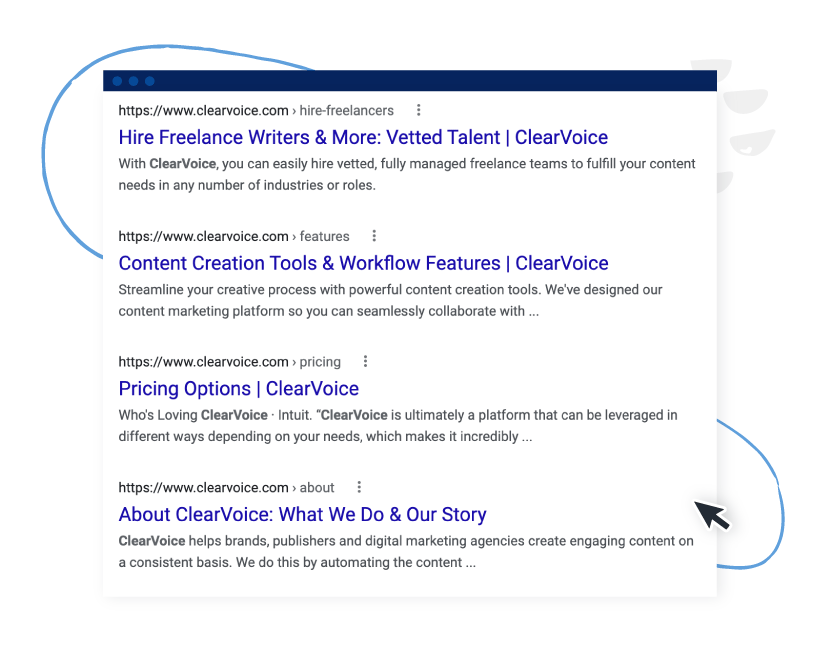Meta descriptions are one of the most important aspects of search engine optimization for your web content. These specialized tags provide potential web visitors with a snapshot of what your website is about, and convince them to click through to your page.
It’s worth your time to understand how meta descriptions work and learn to write strong copy that will help improve your SEO rankings and encourage clicks.
In this post, we break down what meta descriptions are and how to write a compelling meta description to increase clicks.
Let’s dive in.
What is a meta description?
Meta descriptions are the brief text snippets that appear below a page’s title in the search engine results pages. Google displays up to 160 characters of your meta description, so make every word count.
In short, the meta description is the sales pitch for your page. When a web visitor looks at a search results page, the titles and descriptions help them choose which page to click on and read.
That’s why the text you write for these snippets needs to be compelling and contain a call to action (CTA) that encourages people to visit your page.
Understanding meta tags
Before we go any further, let’s be clear about exactly what meta tags are and how they work.
The code for every web page includes a “head” section that tells browsers how to display the page. That section contains information like page title, background color, and fonts.
The “head” section also includes meta tags — bits of code that help search engines know how to index and display the page in search results. Web visitors can’t see the meta tags — but search engines can.
Here is a typical collection of meta tags within a head tag:
<head>
<meta charset=”UTF-8″>
<meta name=”title” content=”This is the title the search engine will display”>
<meta name=”description” content=”Your description goes here”>
<meta name=”keywords” content=”this is where you would list the keywords”>
<meta name=”author” content=”Your name here”>
</head>
How to write meta descriptions that bring you traffic
There are a handful of rules and best practices that govern how to write a good meta description.
- Keep it short
- Make it unique
- Be authentic
- Use relevant keywords
- Make strong word choices
- Focus on the reader
- Write a compelling CTA
Let’s look at each of these rules in depth.
Keep it short & sweet
Your meta descriptions should be under 160 characters because that’s the maximum Google will display on the search results page.
If you remember when Twitter posts were limited to 140 characters, you already have a sense of how much you can cram into 160 characters. Think of your meta descriptions as mini-Twitter posts — with a bit more room for keywords and a call to action.
Make it unique

One of the most common SEO mistakes is writing duplicate meta descriptions for multiple pages on your website. If your site has hundreds or thousands of pages, that’s a lot of potential overlap.
To avoid that problem, take the time to write unique meta descriptions for each page on your website. This will not only improve your SEO rankings but also help you avoid being penalized by Google for duplicate content.
Be authentic
There’s no point in writing a compelling description that doesn’t accurately describe your content. If people click through and find that your content isn’t what they expected, they’ll click back to return to the search results and your bounce rate will go up.
If you can’t entice people to read your content by describing it honestly, you need to revise the content rather than the description.
Use relevant keywords
When you’re writing meta descriptions, it’s essential to use relevant keywords that accurately describe your page’s topic.
You don’t want to stuff your meta descriptions full of keywords, but a couple of strategically placed ones can help improve your click-through rate (CTR). Use the same keywords that you’re targeting with your on-page optimization, in your title, topic headings, and copy.
To choose the right keywords, you can use Google AdWords Keyword Planner or a similar keyword research tool that can help you understand which keywords are being searched most often in your industry.
Make strong word choices
Your meta descriptions should be clear, concise, and persuasive. Prune out weak words and replace them with more robust language.
For example, instead of “nice” or “good,” try “valuable.” Or instead of an “interesting blog post,” how about a “must-read article?”
Ditch most of your adjectives and adverbs by making your nouns and verbs work harder. For example:
- “Your sales will grow really fast” becomes “Your sales will skyrocket.”
- “Choose words that will have an impact” becomes “Choose words that sizzle.”
- “Finish tasks faster than before” becomes “Rip through your to-do list.”
Another way to strengthen your language is to include power words. Examples of power words include:
- Proven
- Free
- Exclusive
- Instantly
- New
- Popular
Be relentless in removing weak language from your descriptions, and replace feeble language with compelling words that make people want to take action.
Focus on the reader
When writing meta descriptions, always think about what’s in it for the reader. What are they going to get out of clicking on your result?
Instead of telling them what your post includes, tell them what they’ll be able to do after reading it that they couldn’t do before.
Here are a few examples:
- “How to tie a bowtie” becomes “Master the perfect bowtie knot in minutes.”
- “Best time to buy a car” becomes “Get the best deal on your next car.”
- “How to make a paper airplane” becomes “Make an origami airplane that flies.”
Write a compelling CTA
Your meta description should include a call-to-action encouraging people to click on your result.
Your CTA could be as simple as “Read now” or “Find out more.” But if you want to get creative, try something like this:
- Improve your results today
- Have your marketing plan finished in two hours
- Put your fitness on autopilot in one afternoon
- You’ll want to bookmark this one
Common meta description errors
One mistake many content writers make with meta descriptions is keyword stuffing. This happens when you try to cram too many keywords into your meta description in an attempt to improve your SEO.
This will not only hurt your rankings, but it will also make your result look spammy and unappealing to readers. In addition, Google will likely penalize you for keyword stuffing, so it’s best to avoid it altogether.
Another mistake is writing meta descriptions that are too long. Remember, your meta description should be no more than 160 characters. Google will cut off anything beyond that in its search results.
Repeating words from the title in your description is also a common error. Your title and meta description should be complementary, but they shouldn’t say the same thing.
Repetition is not your friend when you only have a few words to get your message across. People will see the title above the description, so you can treat it as your first sentence in most cases.
Finally, as we mentioned before, one of the most common mistakes is not writing unique meta descriptions for each page on a website. Search engines should be able to clearly tell where to send visitors for specific information on your site.
If you’re using the same keyword and descriptions for multiple pages, it will be difficult for Google to know which result is most relevant.
Examples of effective meta descriptions
Here are some meta descriptions for the top five websites in the world.
- Google: Search the world’s information, including webpages, images, videos, and more. Google has many special features to help you find exactly what you’re looking for…
- YouTube: Enjoy the videos and music you love, upload original content, and share it all with friends, family, and the world on YouTube.
- Facebook: Create an account or log into Facebook. Connect with friends, family and other people you know. Share photos and videos, send messages and get updates.
- Twitter: From breaking news and entertainment to sports and politics, get the full story with all the live commentary.
- Wikipedia: Wikipedia is a free online encyclopedia, created and edited by volunteers around the world and hosted by the Wikimedia Foundation.
Interestingly, the only site that doesn’t honor Google’s 160-character limit is Google itself.
Every site except Twitter used its name in its meta description. When you’re so well-known that people search for you by name, your name becomes your primary keyword.
You may also notice that every one of these sites describes itself from the user’s point of view. They’re not trying to explain who they are. they’re telling you what they can do for you.
But those are all homepage descriptions. Next, let’s see how Google has composed meta descriptions for some of the recent content on its blog, The Keyword.
- A productivity expert’s tips for returning to the office: Many people are going back to the office, others are staying home. Wherever you are, here’s how to make it work.
- How data drives a hyperlocal news strategy in Los Angeles: The Crosstown Neighborhood Data Project found a way to send out 110 unique email newsletters, one for every neighborhood.
- Get more information about your apps in Google Play: Learn about the new Google Play data safety section, created to provide transparency into how Google Play app data is collected and shared.
- Take a bite out of these scrappy recipes from Google chefs: Here are recipes and tips on how to reduce food waste at home from the chef behind Google’s food program
You can see that the descriptions complement the titles. Some of them promise the reader actionable information, while others describe the content and make it clear why a reader would want to see the full post.
A checklist for your meta descriptions
Writing compelling, keyword-rich meta descriptions that are also short and to the point isn’t easy. We’ve seen that a good meta description has strong language, relevant keywords, is reader-focused, and includes a call to action. That’s a lot to cram into 160 characters, so here’s a cheat sheet you can use to make sure your descriptions are hitting the mark:
- 160 characters or less
- Contains relevant keywords
- No feeble language (nice, good, interesting)
- Weak nouns and verbs replaced with strong ones
- Uses persuasive power words
- Minimal use of adjectives and adverbs
- Tells the reader what they will gain from reading this post
- Is unique (not the same as any other page)
- Don’t repeat the main words from the title
- Accurately describes the content
The bottom line
SEO can be a complex and confusing topic for many business owners, but nailing your meta descriptions is a great place to start. By following these tips you can write unique, compelling meta descriptions that help your website stand out in search results and encourage clicks.
If you need help writing optimized content for your business, from blog posts to metadata, our SEO experts and professional writers have you covered. Talk to a content specialist to learn more.






